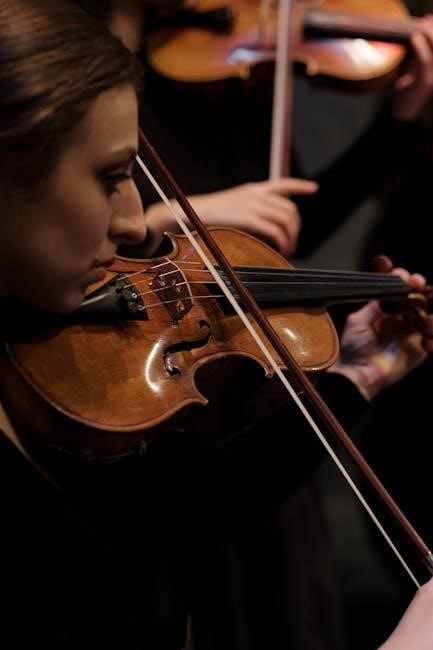Jules Massenet’s Méditation is a breathtaking piece from his opera Thaïs, known for its serene beauty and emotional depth. Originally written for violin and orchestra, it has become a beloved piece for solo violin performance, showcasing the instrument’s expressive capabilities. This iconic work continues to captivate audiences with its melodic elegance and spiritual resonance, making it a cornerstone of classical violin repertoire.
1.1. Who Was Jules Massenet?

Jules Massenet was a renowned French composer, born on May 12, 1842, in Montaud, France. He was a prominent figure in the late Romantic era, best known for his operas and lyrical works. Massenet studied at the Paris Conservatoire and later became a professor there, influencing many future composers. His music is characterized by its sensuality, elegance, and emotional depth. Works like Manon and Werther solidified his reputation as a master of French opera. Massenet married in 1866 and had two children, continuing to compose until his death on August 13, 1912;
1.2. The Significance of “Méditation” from Thaïs
Jules Massenet’s Méditation is an exquisite interlude from his opera Thaïs, written in 1894. It captures a moment of profound spirituality, reflecting the opera’s themes of faith and redemption. The piece is celebrated for its lush, lyrical melody, which showcases the violin’s expressive qualities. Its beauty and emotional depth have made it a standalone favorite, often performed in concerts and used in various arrangements. The Méditation is not only a technical challenge but also a heartfelt expression of devotion, resonating deeply with audiences and musicians alike.
1.3. Why “Méditation” is Popular Among Violinists
“Méditation” is a beloved piece among violinists due to its lyrical and emotive qualities, offering a perfect blend of technical challenge and musical expression. Its soaring melody and rich harmonies allow for deep interpretation, making it a favorite for recitals and auditions. The piece’s expressive range, from delicate passages to powerful climaxes, appeals to both intermediate and advanced players. Additionally, its adaptability to various arrangements and its timeless beauty ensure its enduring popularity in classical violin repertoire, inspiring violinists to master and share its beauty.

The Sheet Music Explained
The sheet music for Massenet’s Méditation provides a detailed guide to performing the piece, featuring the violin solo and orchestral or piano accompaniment. It captures the work’s melodic richness and emotional depth, with clear notation and expressive markings to aid interpretation. The sheet music is essential for understanding the piece’s structure, dynamics, and phrasing, ensuring violinists can deliver a heartfelt and technically precise performance, connecting deeply with the music’s essence and emotional resonance.
2.1. Structure and Composition of the Piece
Massenet’s Méditation is a lyrical piece from his opera Thaïs, showcasing a serene and contemplative melody. The composition features a violin solo accompanied by orchestra or piano, with a gentle, flowing rhythm that builds tension and resolves peacefully. The piece is structured in a ternary form, with a main theme introduced by the violin, developed with harmonic richness, and reprised for a tranquil conclusion. Its modulation from D major to F# minor and back enhances the emotional journey, blending technical precision with profound musicality and emotional depth, making it a timeless favorite for violinists and audiences alike.
2.2. Key and Tempo for Violin Performance
Massenet’s Méditation is written in the key of D major, providing a warm and rich tonal quality for the violin. The tempo is marked as Andante, with a moderate pace that allows for expressive phrasing. Typically performed between 66 to 76 BPM, the piece requires a steady yet flexible tempo to maintain its contemplative character. The key of D major is well-suited for the violin, utilizing the instrument’s upper registers to create a sense of brilliance and emotional depth. The modulation to F-sharp minor adds contrast, while the dynamics remain primarily within mezzo-piano to mezzo-forte, preserving the piece’s serene and meditative essence.
2.3. Instrumental Arrangements for Violin
Massenet’s Méditation is available in various instrumental arrangements tailored for violinists. The original orchestral version features a lush accompaniment, while piano reductions are popular for practice and recitals. Solo violin arrangements emphasize the melody’s lyrical qualities, often with subtle harmonic additions. Some versions include guitar or harp accompaniment for a more intimate feel. These arrangements cater to different performance settings, allowing violinists to interpret the piece in diverse musical contexts while preserving its iconic beauty and emotional impact. This versatility ensures the work remains accessible to musicians of all levels.
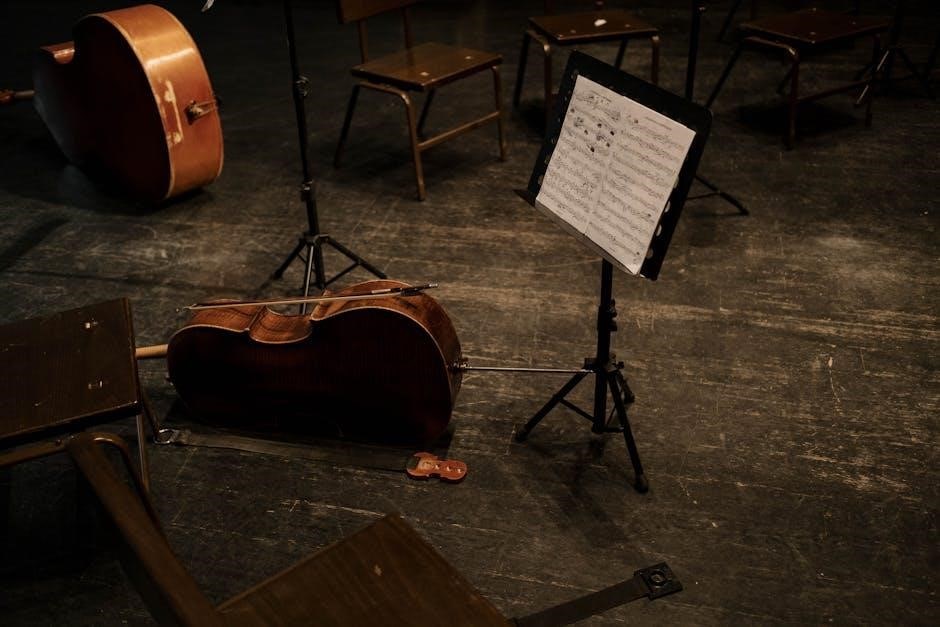
The Importance of Sheet Music in Learning
Sheet music is essential for learning Méditation, as it provides a visual guide to notes, rhythms, and dynamics. It ensures accuracy and helps musicians interpret the composer’s intent effectively, fostering proper technique and expression from the outset.
3.1. Benefits of Using Sheet Music for Practice
Sheet music provides accuracy and precision, ensuring musicians play the correct notes, rhythms, and dynamics. It serves as a reliable reference, preventing the development of poor playing habits. By following the score, violinists can improve sight-reading skills, develop discipline, and gain a deeper understanding of the piece. Sheet music also highlights important musical elements like bowing techniques, articulations, and phrasing, which are essential for an expressive performance. Regular practice with sheet music fosters mastery of Méditation’s intricate melodies and emotional nuances, making it an indispensable tool for learning and perfecting the piece.
3.2. How Sheet Music Helps in Understanding the Composition
Sheet music provides a clear visual representation of the composition, revealing its structure, dynamics, and phrasing. It allows violinists to analyze the melody, harmony, and rhythm, ensuring a precise interpretation of Massenet’s intent. By studying the score, musicians can identify key themes, transitions, and emotional peaks, gaining insight into the piece’s narrative and technical demands. Sheet music also highlights tempo markings, bowing techniques, and articulations, essential for capturing the work’s essence. This detailed access fosters a deeper connection to the composition and enhances overall musical understanding.
3.3. Tips for Reading Sheet Music Effectively
To read sheet music effectively, start by understanding note values, rests, and dynamics. Pay attention to articulations, phrasing, and bowing techniques specific to the violin. Practice sight-reading slowly, gradually increasing tempo as familiarity grows. Focus on key signatures and accidentals to maintain pitch accuracy. Use a metronome to ensure precise timing and rhythm. Highlight complex passages for focused practice. Finally, connect with the music’s emotional essence, translating visual notes into expressive performance. Effective sheet music reading bridges technical skill and artistic interpretation.
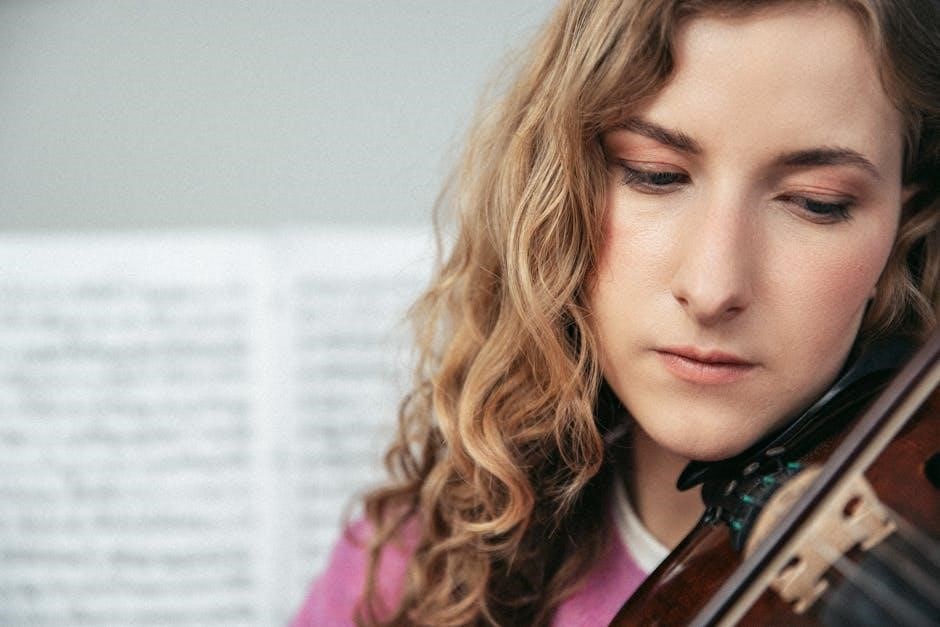
Finding the Right Version for Your Skill Level
Selecting the right version of Massenet’s Méditation for your skill level is essential. Beginner arrangements simplify the piece, while intermediate and advanced versions add complexity. Choose an edition that matches your technical ability and musical goals for the best learning experience.
4.1. Beginner-Friendly Arrangements
Beginner-friendly arrangements of Massenet’s Méditation simplify the piece while retaining its essence. These versions often feature slower tempos, reduced technical complexity, and simplified bowing techniques. They are ideal for new learners, allowing them to focus on developing proper intonation and phrasing without overwhelming challenges. Many beginner arrangements also transpose the piece into more violin-friendly keys, making it easier to navigate. These adaptations ensure that even less experienced players can enjoy and learn from this beautiful work, building foundational skills and confidence.
4.2. Intermediate and Advanced Versions
Intermediate and advanced versions of Massenet’s Méditation offer greater complexity and nuance, catering to musicians with refined skills. These arrangements maintain the original composition’s integrity while incorporating challenging techniques such as intricate phrasing, double stops, and higher positions. Advanced players can explore the piece’s expressive depths, emphasizing dynamics and articulation. These editions are ideal for those seeking to refine their technical proficiency and interpretive abilities, providing a rewarding experience that highlights the violin’s capabilities in conveying emotion and sophistication.
4.3. Choosing the Right Edition for Your Needs
Selecting the appropriate edition of Massenet’s Méditation ensures a tailored learning and performance experience. Consider your skill level, with beginner versions offering simplicity and advanced editions providing complexity. Some sheets include piano accompaniment, while others feature orchestral reductions or solo arrangements. Look for editions with clear fingerings, bowing marks, and dynamics to aid interpretation. Additionally, compare publishers for quality and accuracy. Ultimately, choose an edition that aligns with your technical abilities and performance goals to maximize both enjoyment and artistic expression.
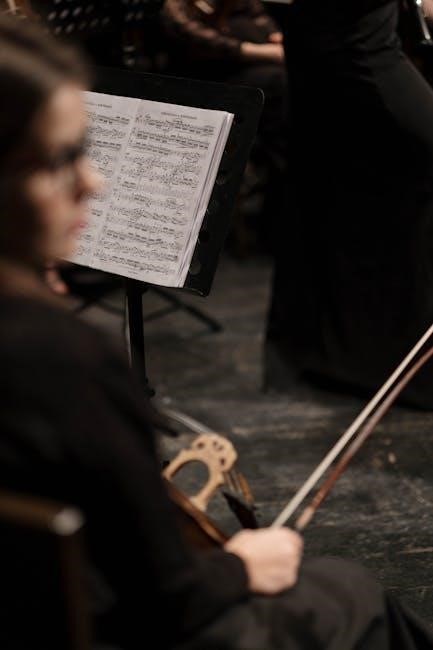
Downloading Massenet Meditation Violin Sheet Music PDF
Downloading Massenet’s Méditation as a violin sheet music PDF is simple and widely accessible. Explore trusted platforms offering high-quality scores, ensuring clarity and accuracy for optimal performance.
5.1. Reliable Sources for Sheet Music PDFs
For high-quality Méditation sheet music PDFs, consider reputable platforms like Musicnotes, Sheet Music Plus, or the International Music Score Library Project (IMSLP). These sites offer accurate transcriptions, ensuring authenticity and clarity. Subscription-based services often provide additional benefits, such as interactive tools and multiple arrangements. Always verify the source’s credibility to avoid low-quality or unauthorized versions. Prioritizing legal and reliable sources guarantees a seamless learning and performance experience for violinists of all skill levels.
5.2. Free vs. Paid Sheet Music: What’s Best?
When searching for Méditation sheet music, you’ll find both free and paid options. Free versions are ideal for initial exploration and budget-conscious learners, often available on platforms like IMSLP. However, paid sheet music typically offers higher quality, accuracy, and additional features like interactive tools or multiple arrangements. For serious study or performance, investing in paid versions ensures precision and reliability. Consider your needs: free for casual practice, paid for professional-grade materials and support.
5.3. Ensuring Legal and Ethical Downloads
Downloading sheet music legally and ethically is crucial to support composers and publishers. Always use reputable platforms like IMSLP or licensed sellers such as Musicnotes. Verify if the work is in the public domain or under copyright. For copyrighted pieces, ensure you’re using authorized arrangements. Avoid illegal downloads, as they harm creators and the music industry. By choosing legal sources, you respect intellectual property and contribute to the sustainability of classical music. Ethical downloading also ensures you receive high-quality, accurate sheet music for the best learning experience.
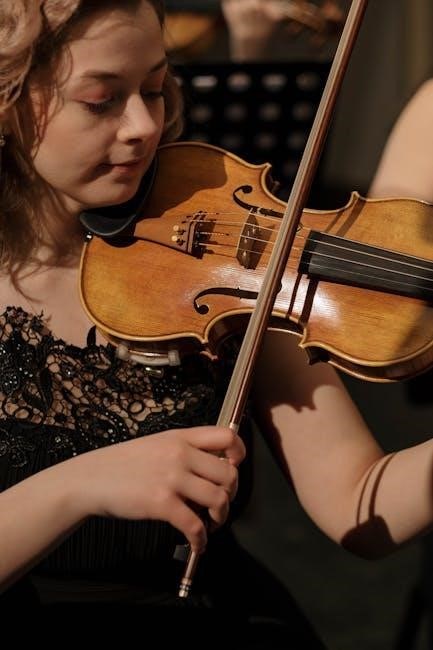
How to Play “Méditation” on the Violin
Mastery of Méditation requires precise technique and emotional sensitivity. Focus on the flowing melody, expressive phrasing, and controlled vibrato. Maintain a steady tempo and nuanced dynamics to convey the piece’s spiritual essence, balancing technical accuracy with heartfelt interpretation for a captivating performance.
6.1. Technical Tips for a Smooth Performance
Achieving a smooth performance of Méditation requires meticulous attention to bow control and intonation. Use a consistent bow speed and focus on legato playing to maintain the piece’s flowing nature. Pay special attention to vibrato width and dynamics to enhance emotional expression. Practice finger placement carefully to ensure precise intonation, especially in the higher registers. Additionally, work on subtle phrasing and articulation to bring out the melody’s lyrical quality. Regular slow practice and metronome use can help refine technical accuracy and rhythmic precision, ensuring a polished and captivating performance.
6.2. Expressing Emotion Through Phrasing
Phrasing is key to conveying the emotional depth of Méditation. Use dynamic contrasts and subtle rubato to create a sense of longing and introspection. Emphasize the lyrical melody by connecting notes seamlessly, allowing the music to breathe. Experiment with varying vibrato widths to add color and expressiveness. Pay attention to the natural rise and fall of phrases, ensuring each one flows into the next. By focusing on phrasing, you can transform the piece into a deeply personal and moving experience for both performer and audience.
6.3. Common Challenges and Solutions
Mastering Méditation presents challenges, such as maintaining pitch accuracy in the higher register and achieving a smooth, lyrical tone. Intonation and bow control are critical, especially in the piece’s soaring melodies. To address these, practice slowly with a metronome and focus on precise finger placement. Use vibrato judiciously to enhance emotional depth without sacrificing clarity. Break difficult passages into smaller sections and gradually build tempo. Recording your practice can help identify and correct issues, ensuring a polished and expressive performance.

The Role of Accompaniment
Accompaniment plays a vital role in Méditation, providing harmonic richness and emotional depth. Orchestral or piano arrangements enhance the violin’s melody, allowing for nuanced expression and dynamic control.
7.1. The Importance of Orchestral Accompaniment
The orchestral accompaniment in Méditation provides a lush, harmonic foundation that complements the violin’s melodic line. It enhances the emotional depth and creates a dynamic interplay between the soloist and the ensemble. The orchestra’s subtle textures and nuanced phrasing support the violin’s expressiveness, while its crescendos and decrescendos add dramatic contrast. This interdependence between the soloist and the orchestra is essential for conveying the piece’s spiritual and lyrical qualities, making it a cornerstone of orchestral accompaniment in classical music.
7.2. Using Piano Accompaniment for Practice
Piano accompaniment is a practical and effective way to practice Méditation when an orchestra is unavailable. It provides harmonic support and rhythmic guidance, helping the violinist maintain timing and balance. The piano reduction captures the essence of the orchestral score, offering a more accessible format for rehearsals. This setup allows the violinist to focus on technique, phrasing, and emotional expression without the logistical challenges of coordinating a full ensemble. Additionally, piano accompaniment is cost-effective and widely available in sheet music editions, making it an ideal choice for both practice and performance preparation.
7.3. Exploring Modern Accompaniment Options
Modern technology has revolutionized how musicians practice and perform Méditation. Digital accompaniment tools, such as software and mobile apps, offer flexible and accessible ways to rehearse. Pre-recorded backing tracks with orchestral or piano arrangements provide a rich, immersive experience without requiring live accompaniment. These tools allow violinists to adjust tempos, explore different arrangements, and practice consistently. Additionally, digital solutions are cost-effective and convenient, making them ideal for musicians at all levels. They also enable seamless transitions between practice and performance, ensuring a polished and engaging interpretation of Massenet’s timeless piece.
Performance and Interpretation
Performing Méditation demands a balance of technical precision and emotional depth. Violinists must convey the piece’s serene beauty while maintaining nuanced phrasing and dynamics, creating a captivating experience for listeners.
8.1. Historical Performances of “Méditation”
The premiere of Méditation took place in 1894 during the first performance of Massenet’s opera Thaïs. Originally scored for solo violin, orchestra, and chorus, the piece quickly gained fame for its lyrical beauty. Over the years, it has been performed by legendary violinists, with early recordings by artists like Jascha Heifetz and Fritz Kreisler setting benchmarks for interpretation. These historical performances not only showcased the technical demands of the piece but also highlighted its emotional and spiritual essence, solidifying its place in classical violin repertoire.
8.2. Modern Interpretations and Arrangements
Modern interpretations of Méditation showcase the piece’s timeless appeal, with contemporary violinists offering fresh perspectives. Many artists have reimagined the work, blending traditional techniques with innovative styles, such as adding improvisational elements or fusing it with other genres like jazz or electronic music. Additionally, new arrangements for solo violin, viola, or even ensembles have emerged, expanding its accessibility. These modern takes not only honor Massenet’s original composition but also introduce it to new audiences, ensuring its relevance in today’s musical landscape.
8.3. Bringing Your Own Style to the Piece
Violinists can infuse Méditation with personal flair by experimenting with phrasing, dynamics, and vibrato. While respecting Massenet’s intent, players can interpret the melody to reflect their unique emotional expression. Studying iconic recordings can inspire, but finding one’s voice ensures authenticity. Whether through subtle tempo variations or nuanced articulations, making the piece one’s own fosters a deeper connection. Balancing technical precision with artistic freedom allows performers to deliver a compelling, individualized rendition that honors the composition while showcasing their distinct style.

Cultural and Historical Context
Jules Massenet’s Méditation from Thaïs reflects late 19th-century French opera’s elegance and spirituality. Composed in 1894, it captures the era’s musical sophistication, blending lyricism with religious themes, enduring as a cultural treasure.
9.1. The Opera “Thaïs” and Its Legacy
Jules Massenet’s opera Thaïs, premiered in 1894, is a masterpiece of French opera, blending sensuality and spirituality. Based on Anatole France’s novel, it tells the story of a courtesan’s conversion to Christianity. The opera’s rich orchestration and lyrical melodies showcase Massenet’s compositional genius. Its legacy endures, with Méditation standing out as a timeless highlight, often performed independently. This piece encapsulates the opera’s emotional depth, making it a cornerstone of classical music and a favorite among violinists worldwide for its technical and expressive challenges.
9.2. The Evolution of “Méditation” in Popular Culture
Méditation has transcended classical music, becoming a staple in popular culture. It has been featured in films, TV shows, and commercials, often evoking serene and emotional moments. The piece’s universal appeal has led to countless arrangements, from piano covers to modern electronic remixes. Its melody is frequently used in music therapy and relaxation playlists, further cementing its place in contemporary culture. This adaptability ensures that Méditation continues to inspire new generations, bridging the gap between classical and modern audiences alike.
9.3. How “Méditation” Influenced Other Composers
Méditation has left an indelible mark on classical music, inspiring many composers to explore similar emotional and technical depths. Its lyrical beauty and expressive phrasing have influenced works by later Romantic and modern composers. The piece’s ability to evoke profound emotion through simple yet powerful melodies has set a benchmark for violin writing. Composers like Puccini and others have drawn inspiration from its orchestration and thematic development. This iconic piece continues to shape the way composers approach emotional expression and technical challenges in their own works.
Jules Massenet’s Méditation remains a timeless masterpiece, cherished for its elegance and emotional depth. Its influence continues to inspire violinists and composers alike, ensuring its enduring legacy in classical music.
10.1. The Enduring Appeal of “Méditation”
Jules Massenet’s Méditation from Thaïs captivates audiences with its lyrical beauty and emotional depth. Its serene melodies evoke a spiritual connection, resonating across generations. The piece’s simplicity, combined with its technical demands, makes it a favorite among violinists. Its versatility in arrangements, from orchestral to solo performances, further enhances its appeal. As a result, Méditation remains a timeless classic, bridging the gap between classical and contemporary music, ensuring its lasting place in violin repertoire and the hearts of music lovers worldwide.
10.2. Final Thoughts on Learning and Performing
Mastering Méditation requires dedication and a deep connection to its emotional essence. Approach practice with patience, focusing on phrasing and tone quality to convey its spiritual depth. Embrace the challenges as opportunities for growth, and remember that interpretation is personal. When performing, let the music flow naturally, sharing its beauty with others. Whether for personal enjoyment or public performance, Méditation offers a rewarding experience that enriches both the player and the audience, making it a timeless piece to cherish.
10.3. Encouragement for Aspiring Violinists
Embrace the journey of learning Méditation with passion and patience. This piece, while challenging, offers immense rewards for those willing to delve into its beauty. Remember, mastery takes time, and every small progress is a step forward. Don’t be discouraged by difficulties—instead, view them as opportunities to grow. Practice mindfully, connect with the music’s emotion, and let your violin sing. Most importantly, enjoy the process of bringing this timeless masterpiece to life and sharing its elegance with others.
Additional Resources
Discover recommended websites for sheet music, practice tools, and apps to enhance your learning experience. Explore further reading on Massenet’s life and works for deeper insight into his compositions.

11.1. Recommended Sheet Music Websites
For high-quality Méditation sheet music, explore these trusted platforms:
- Musicnotes: Offers a wide range of arrangements and transpositions.
- Sheet Music Plus: Provides comprehensive collections for violinists.
- IMSLP: A free resource with public domain and contemporary scores.
- Virtual Sheet Music: Specializes in classical pieces with clear formatting.
- JW Pepper: Features detailed previews and multiple versions.
These sites ensure access to accurate and beautifully rendered PDFs for practice and performance.
11.2. Suggested Practice Tools and Apps
Enhance your practice with these essential tools and apps:
- Tempo: A precise metronome for maintaining perfect timing.
- TonalEar: Aids in developing pitch recognition and intonation skills.
- Forscore: An app for managing and annotating sheet music digitally.
- AmazingMIDI: Converts MIDI files to sheet music for study.
- Practice+: Tracks progress and offers customizable practice sessions.
These tools streamline your practice routine, helping you master Méditation effectively.
11.3. Further Reading on Massenet and His Works
For a deeper understanding of Jules Massenet and his compositions, explore these recommended resources:
- Massenet: A Biography by Demar Irvine offers insights into the composer’s life and creative process.
- The Operas of Massenet provides analytical studies of his major works, including Thaïs.
- Massenet and the French Opera Tradition examines his role in shaping French opera.
- Massenet: His Life and Works is a comprehensive guide to his legacy.
- Various essays and articles in music journals discuss his influence and compositional style.
These resources enrich your appreciation of Massenet’s artistry and historical significance.
